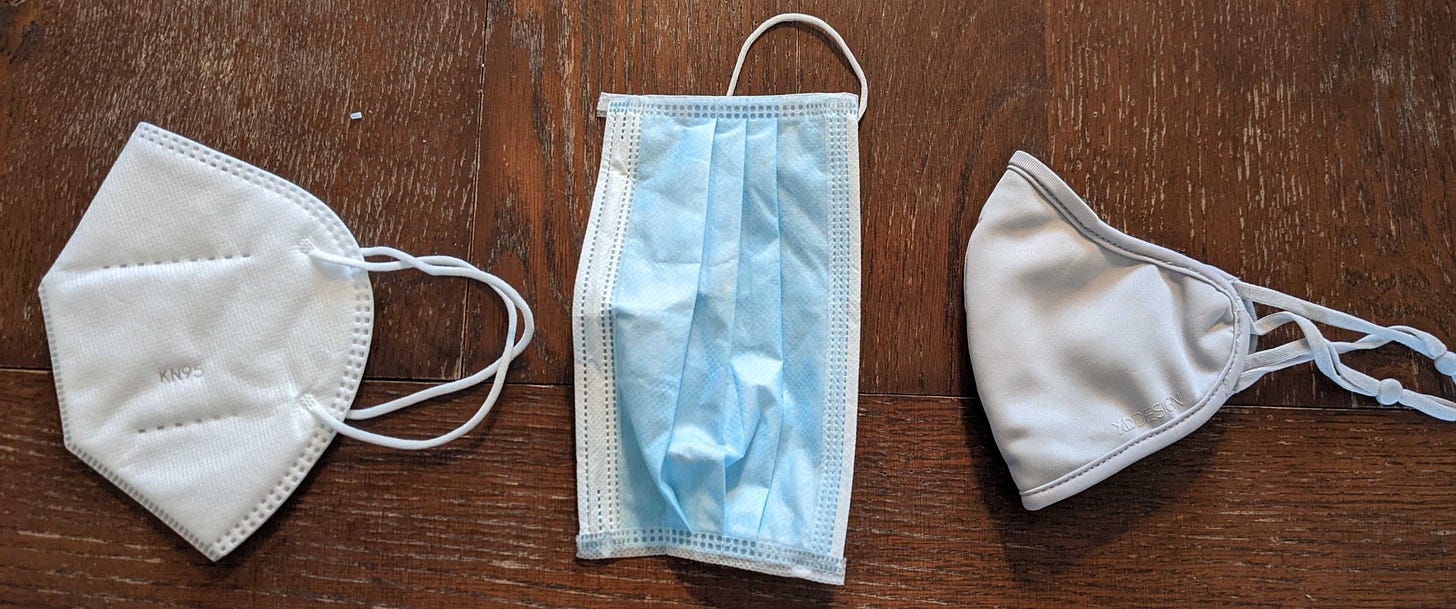Upgrade those Masks
We are no longer looking for better better-than-nothing solution to preventing COVID-19
The Omicron Varient of COVID-19 has been on an exponential growth path for the last few weeks. There is evidence that the United States and Western Europe may be at the top of this most recent wave, but I would not bet on it being the last wave. As we move beyond this wave, something everyone needs to do for the next one is upgrading their masks. Cloth face masks provide minimal protection and supply chains no longer force us to adopt a better-than-nothing footing.
Vaccinations are the best way to prevent COVID-19, but breakthrough cases are becoming more common. People who received the single-shot Jansen vaccine, as I did, appear to be more at risk of a breakthrough infection than people who received the two-shot mRNA vaccines. To bridge the gap, most countries have recommended wearing a facemask of some kind.
Not all masks are equal
Early in the pandemic, we turned to cloth face masks. They were cheap and easy to make at home or mass produce in garment factories. Additionally, they reduced strain on the overburdened supply chain that could not make surgical masks and N95-type respirators1 in sufficient quantities. This is no longer true today. Access to surgical masks (and to a lesser extent N95-type respirators) is no longer constrained. However, until recently, the Biden administration has still been boosting cloth masks as a way of protecting people against COVID-19.
The American Conference of Governmental Industrial Hygienists, based on CDC data, has released the protection time for various masks. This is the amount of time needed to get a dose of the COVID-19 virus large enough to cause an infection. If you get COVID based on this dose carries depends on the strength of your immune system and your vaccination status. Think of this as a worst-case scenario instead of a normal scenario. The data can be seen in the table below.

The striking thing is that a cloth mask provides very little extra time compared to wearing nothing. They provide only 5 extra minutes with one person wearing a cloth mask and 12 extra minutes for both people wearing one. Surgical masks are better than cloth masks and provide extra time. However, short of everyone wearing a surgical mask, all no mask, cloth mask, and surgical mask scenarios end up in the red zone of providing less than an hour of exposure before receiving an infectious dose.
The majority of the scenarios in the yellow zone of 1-4 hours involve one person wearing an N95-type respirator and the other having a cloth mask or less. N95-type masks are more expensive than surgical masks but provide a much higher degree of protection. The one thing that I would point out is that everyone wearing a surgical mask, like I mostly see here in Denmark, allows for an hour of exposure. Getting everyone in the US to at least wear a surgical mask would have immense benefits.
The green zone is 4 or more hours of protection. All of the scenarios reflect at least one person wearing an N95-type respirator and the other wearing a surgical mask or better. Something to note is that outside of everyone wearing an N95, no scenario protects someone for an entire 8-hour workday.
Most people should ignore the gray band of numbers along the outside. Unless you wear a respirator with a rubber gasket or have been trained to seal a disposable N95 through your job, those numbers are unattainable. Think of this as the protection that doctors and nurses get in a clinical setting.
What should I do?
If you are in an area with a high amount of community spread of the COVID-19 virus, you should consider upgrading your mask. Moving from a cloth mask to a surgical mask or a surgical mask to an N95 mask will provide more protection. If I worked in the service industry or at a job where I needed to be in person, I would not wear anything less than an N95.
In addition to upgrading your mask, if you are not currently boosted please get your booster shot. It will provide significant protection against the virus. If you live in a place like I do, with plentiful at-home and in-person testing get tested before you meet with people. Knowing if you have the virus will help you not spread it.
Wikimaps
I have made another map for a Wikipedia article. 20 articles illustrated and 80 more to go!
This includes all disposable masks that are up to American N95 standards, reusable N95 or better masks, and disposable masks KN95 masks based on the Chinese standard.



